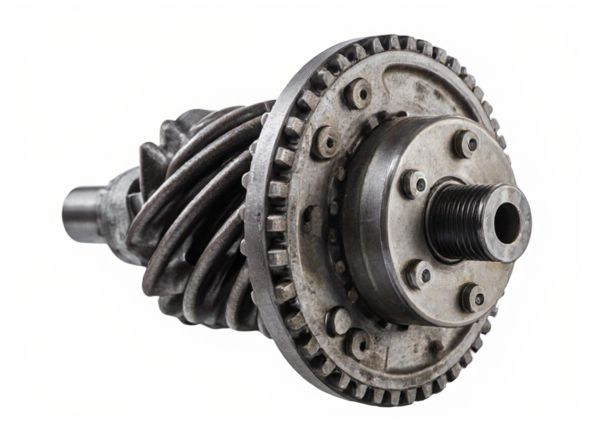
Photo illustration: Active Differential vs Passive Differential
An active differential uses a limited-slip mechanism controlled by electronic sensors and actuators to improve traction by actively distributing torque between wheels. A passive differential relies on mechanical gears, such as a clutch or viscous coupling, to transfer torque based on wheel speed differences without electronic intervention. Understanding how your vehicle's differential operates can help optimize handling and performance in various driving conditions.
Table of Comparison
| Feature | Active Differential | Passive Differential |
|---|---|---|
| Definition | Electronically controlled differential that adjusts torque distribution actively. | Mechanically operated differential allowing wheels to rotate at different speeds. |
| Torque Management | Dynamic torque vectoring based on real-time sensors. | Torque split determined by mechanical components, no active control. |
| Performance | Enhanced traction and cornering stability under various conditions. | Basic traction control, limited cornering support. |
| Complexity | High complexity with sensors, actuators, and electronic control units. | Simple mechanical design, easier maintenance. |
| Cost | Higher production and maintenance cost due to electronics. | Lower cost, widely used in standard vehicles. |
| Application | Sports cars, high-performance vehicles, off-road systems. | Economy cars, SUVs, trucks with standard drivetrains. |
| Reliability | Depends on electronic system integrity; potential for electronic failure. | Proven mechanical reliability over time. |
Introduction to Differentials
Differentials are mechanical devices in vehicles that allow wheels to rotate at different speeds, essential for smooth cornering. Passive differentials typically use gears and friction clutches to distribute torque based on wheel speed differences, offering simplicity and durability. Active differentials employ electronic sensors and actuators to modulate torque dynamically, enhancing traction and handling by adjusting power distribution in real-time.
What is a Passive Differential?
A passive differential is a mechanical device in a vehicle's drivetrain that allows wheels to rotate at different speeds, primarily using gears without external power input. It distributes torque evenly to both wheels but can struggle with traction on slippery surfaces due to equal torque transfer regardless of grip. Passive differentials are simpler and more cost-effective compared to active differentials, which use electronics and sensors to optimize torque distribution dynamically.
What is an Active Differential?
An active differential is a type of automotive differential that uses electronic sensors and actuators to control torque distribution between wheels, enhancing traction and handling performance. Unlike a passive differential, which relies on mechanical components and friction, an active differential dynamically adjusts torque based on driving conditions and wheel slip. This system improves vehicle stability, especially in high-performance and all-wheel-drive applications.
Key Differences Between Active and Passive Differentials
Active differentials use electronically controlled mechanisms to distribute torque dynamically between wheels, enhancing traction and handling performance under varying road conditions. Passive differentials rely on mechanical components like gears to allow wheels to rotate at different speeds but provide limited torque transfer, often resulting in reduced grip during slip scenarios. The key difference lies in active differentials' ability to adjust torque proactively, while passive differentials operate reactively based on mechanical forces.
Performance Benefits of Active Differentials
Active differentials enhance vehicle performance by dynamically adjusting torque distribution between wheels, improving traction and handling during cornering and acceleration. Unlike passive differentials, which rely on mechanical limitations, active differentials use electronic controls and sensors to optimize power delivery, reducing wheel slip and increasing stability. This results in superior responsiveness, better grip on variable road conditions, and improved overall driving dynamics.
Advantages and Disadvantages of Passive Differentials
Passive differentials offer simplicity, lower cost, and reduced maintenance requirements compared to active differentials, making them ideal for standard driving conditions. Their primary disadvantage lies in limited traction control and slower response to wheel slip, which can affect handling and stability in challenging terrains or high-performance scenarios. Despite these drawbacks, passive differentials remain a reliable choice for everyday vehicles due to their durability and ease of integration.
Application Scenarios: When to Use Each Type
Active differentials are ideal for high-performance vehicles and off-road applications where precise torque distribution enhances traction and handling under varying road conditions. Passive differentials suit everyday driving scenarios, providing basic torque distribution that is cost-effective and reliable for consistent traction on paved surfaces. Choosing between active and passive differentials depends on factors like vehicle purpose, terrain complexity, and desired handling characteristics.
Impact on Vehicle Handling and Stability
Active differentials enhance vehicle handling and stability by dynamically adjusting torque distribution between wheels, improving traction during cornering and reducing understeer or oversteer. Passive differentials rely on mechanical limitations and constant torque distribution, which can lead to wheel slippage and less precise control in varying road conditions. The advanced control in active differentials provides better grip, increased safety, and optimized performance on diverse surfaces compared to the simpler, more cost-effective passive systems.
Maintenance and Longevity Considerations
Active differentials require regular maintenance to ensure their electronic components and sensors function properly, which can extend their lifespan but involve higher costs. Passive differentials have simpler mechanical designs with fewer parts subject to wear, resulting in lower maintenance demands and typically longer operational longevity. Choosing between the two depends on balancing the complexity and performance benefits of active differentials against the durability and lower upkeep of passive differentials.
Which Differential is Right for You?
Choosing between an active differential and a passive differential depends on your driving needs and vehicle type. Active differentials provide enhanced traction and improved handling by electronically distributing torque, ideal for performance vehicles and off-road conditions. Passive differentials offer a simpler, cost-effective solution suitable for everyday driving and light terrain without the complexity of electronic control.
 caratoz.com
caratoz.com